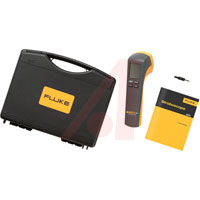FLUKE-820-2產(chǎn)品概述
Investigate and observe potential mechanism failure with confidence
Identifying the running speed of rotating equipment can be difficult, but the Fluke 820-2 LED Stroboscope simplifies the process allowing you to perform stop motion diagnostics without actually stopping, or making contact, with the machine you are working on. Whether you are trying to diagnose parasitic oscillations, slippage, or unwanted distortions, the 820-2 LED Stroboscope is the ideal frontline troubleshooting, process or product research and development tool.
In addition, the LED stroboscope can be used as a strobe tachometer to measure speed instead of using a laser tachometer. In order to use the stroboscope, the component under measure must be visible, and have an identifying mark that can be used as a point of reference. A strobe tachometer is a useful tool because you can't always get access to the machine shaft to stick a piece of reflective tape to use a laser tachometer or make contact with the moving shaft to use a contact tachometer - using a stroboscope you can "stop" the shaft down to 30 RPM (FPM).
Features:
High-intensity 7-LED array – 4,800 Lux @ 6,000 FPM/30cm
High efficiency LED solid-state light source with uniform flash characteristics allows for higher flash rates – 30-300,000 FPM (flashes per minute)
Digital pulse width modulation for exceptionally sharp images at high speeds
Rugged, durable design utilizes solid-state LEDs with no filaments, gases, hollow cavities, or glass – (1 meter drop)
Quartz-accuracy control system provides high accuracy – 0.02% (+/- 1 digit)
Multi-line LCD display
Check the rotating speed of machinery without physical contact or need for reflective tape
Advance or retard flash timing for viewing gear teeth, cutting surfaces, repeats, or drifting equipment
Simple push button operation with 2x and ÷2 buttons for easy adjustment
For most applications the standard flash duration will work well without adjustment. In other applications with higher rpm or larger rotating objects with high surface speeds, an adjustable flash duration is needed. In high speed applications, objects may move during the brief period of a single flash, resulting in a blurred image. By decreasing flash duration, objects have less time to move and the image will appear sharper.
Applications:
Belt driven machines - HVAC fans, pumps
Roller bearings, shafts, gear teeth or other machine components
Clutches and cogwheels
Foundations - resonance vibrations
Cable or piping wear or damage
Turbines that vary in speed and change speed frequently
Variable Frequency Drive motors that vary in speed, but do not change frequently
Find belt rotation speed and look for belt slippage
Find machine element components – fan blades, pump vanes, compressor screws, and gear teeth
RPM measurement and frequency investigation
Slip measurement


 Datasheet
Datasheet